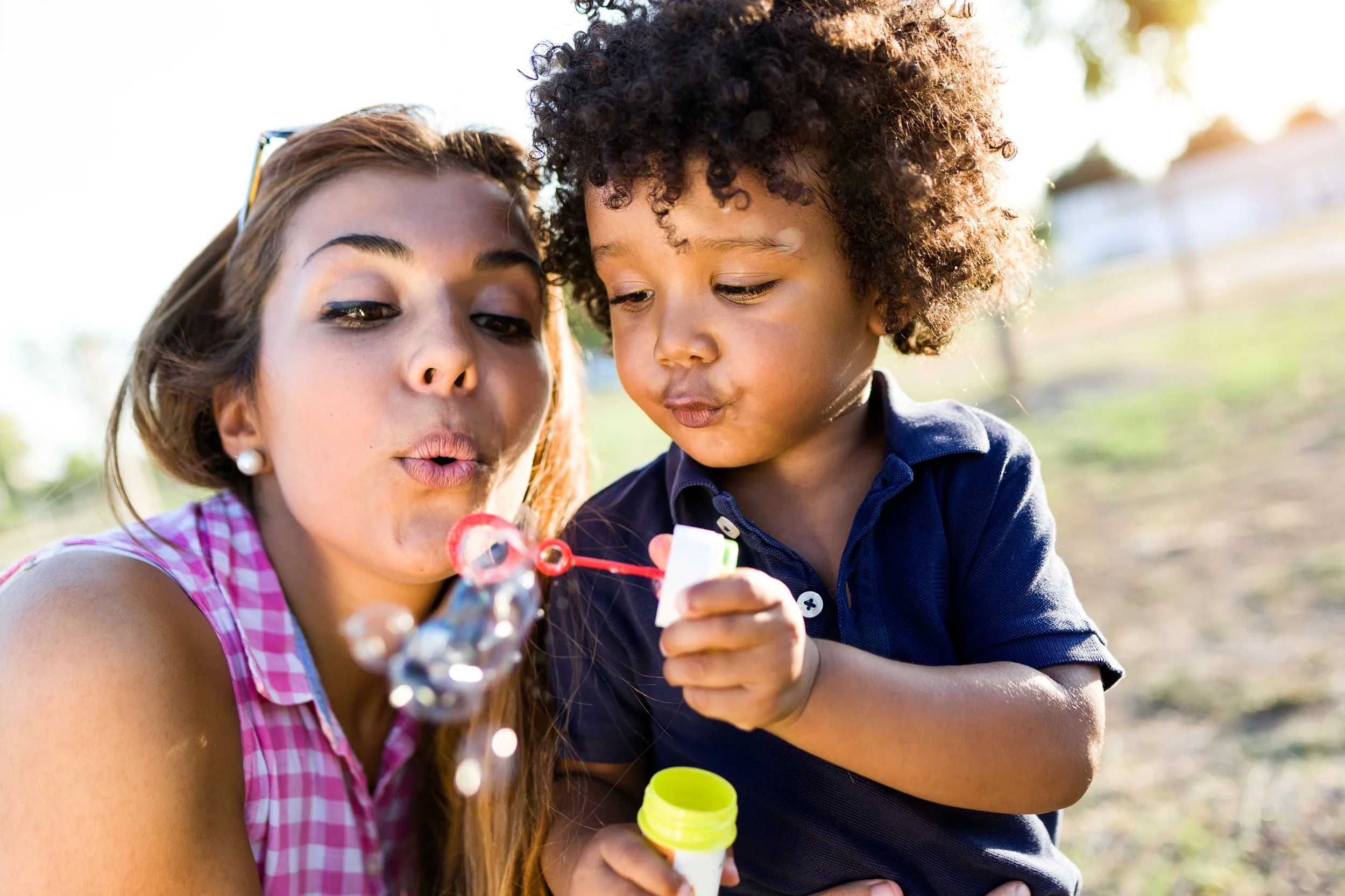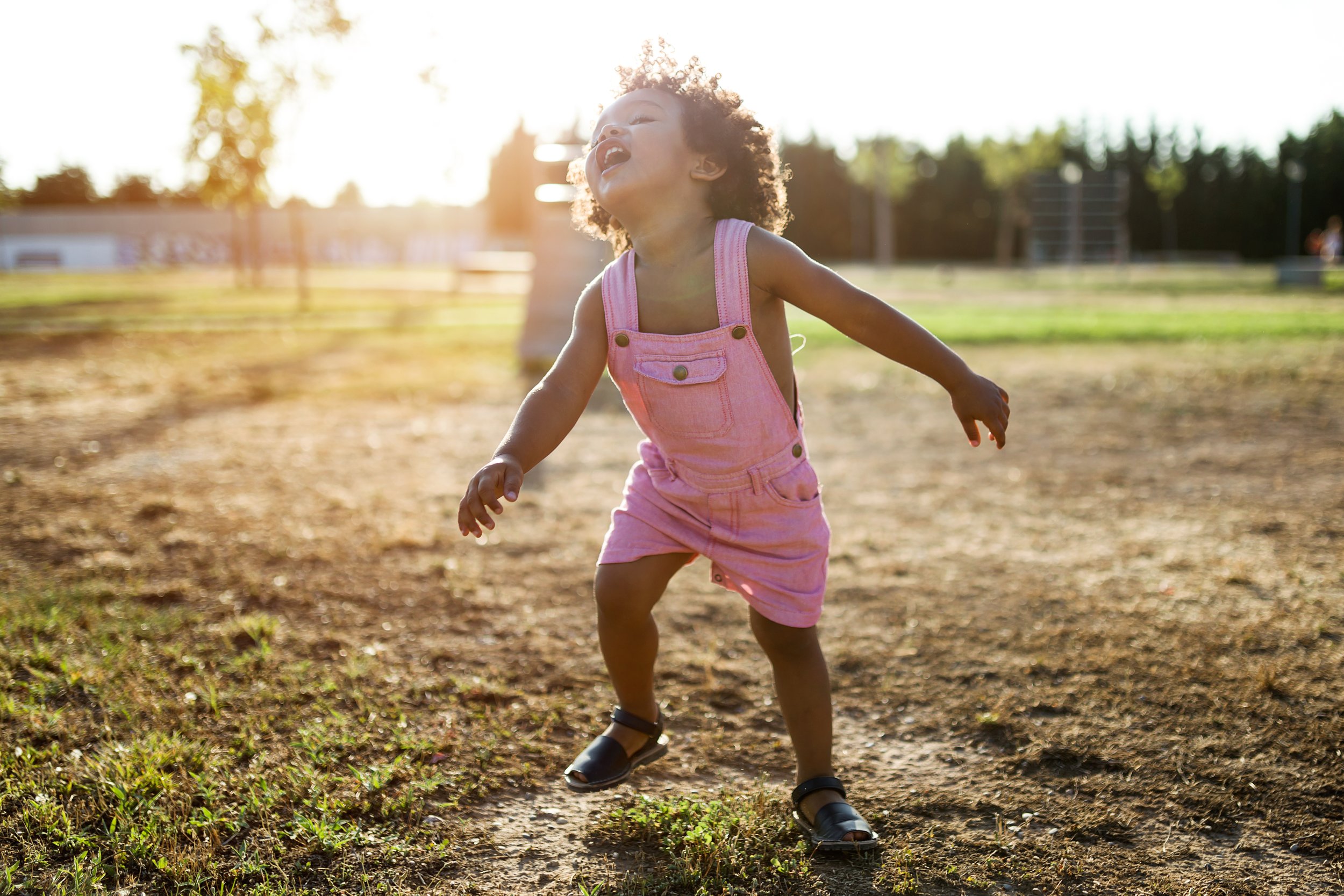Speech Therapy & Bubbles for Kids
You Know You Love Bubbles!
Bubbles. Mega fun in a little package! Bubbles are magical looking, float in the air, and kids love them. They are so simple and such a great activity for your at home speech practice.
In this post we’ll talk about
why we recommend simple no-spill bubbles with a wand
the different levels of bubble play
how to play & what to say to turn your bubble play into at home speech practice
This post contains affiliate links. As an Amazon Associate, Toddler Talk earns from qualifying purchases. Proceeds help support these resources.
Setting up for success
There are lots of different bubbles out there. For the activities we describe to work it’s important that you find, purchase, or create bubbles that:
You can operate yourself. Super simple bubbles with a wand that you blow into are excellent because they help encourage communication.
Are accident-resistant. We highly, HIGHLY recommend “no-spill” bubble containers to keep the fun (and practice) going.
Are simple and manageable. Bubble machines can be fun, but if you choose one please pick one with a button/trigger so you can turn it on easily. Small and portable is better for our activities than large and fancy.
Actually work. In our experience, store-bought bubble solution works well. Unless you have specialty ingredients, homemade bubble liquid (such as simple dish soap) does not produce a satisfying result.
Here are my favorite no-spill bubbles ↓
Bubble Play: Stages
Find the best stage for your child!
In toddlers, play stages and language skills are closely correlated. We’ve broken it down into 3 simple stages (listed below) and provided specific activities you can use for your child’s stage.
Explorers - see the Explorer’s activity
An Explorer doesn’t talk yet, but are exploring communication. They let you know their wants and needs by crying, gesturing, and making sounds.
Pioneers - see the Pioneer’s activity
Pioneers say one, a few, or even as many as 100 words. They are still learning pronunciation skills and they often talk in their own language.
Builders - see the Builder’s activity
Builders talk in short sentences. They enjoy having little conversations and ask questions.
Dive a little deeper: You can read more about our stages of play here.
Explorers
How to Bubble Play & What to Say:
When you play bubbles with your Explorer, you will blow bubbles for them to look at while you say words. You will help them learn to “take a turn” during a simple bubble-blowing routine.
Say, “ready, set, go!” When you say “go!” blow the bubbles around the child. Do this many times so your child becomes familiar with the routine.
After many tries, you will add a pause. Say, “ready, set…” and pause to see if your child does something. They probably won’t say “go!”, but they might wiggle, make a sound, or shift their eye gaze to you. You should interpret this as them telling you “go!”
If they take a turn, blow the bubbles and say “go!” If five seconds pass and they don’t do anything, say “go!” and blow the bubbles anyway.
You can show your Explorer how fun it is to reach for and pop bubbles. You can say “pop! Pop the bubbles!” while you pop them.
You can catch bubbles on a bubble wand and offer it to your child. They might pop the bubble off of the wand, or even try to blow the bubble off of the wand.
Pioneers
How to Bubble Play:
When you play bubbles with your Pioneer, you will teach them the question “where did it go?” and how to ask for “more.”
What to Say:
Tell your child, “we are going to blow bubbles!” Blow bubbles a few times, making sure that you pop the last bubble with your child watching. Act confused and say, “where did it go?” while looking around. Say, “it popped. The bubble popped! I’m going to blow MORE.” Sign “more” when you say the word, then blow more bubbles.
Repeat the routine many times, emphasizing “where did it go,” “it popped,” and “more.” Do the routine at least three times before you try to get your child to answer. You can ask, “where did it go?” and look silently at your child to see if they answer. Wait five seconds before you answer the question yourself (“it popped!”)
After you do the routine several times, wait at the end and see if your child signs (or says) “more” to ask for the routine again.
Builders
How to Bubble Play & What to Say:
When you play bubbles with your Builder, you will use the bubbles to make a “car wash.” You will help them make and understand short sentences about where you will blow the bubbles in order to “wash” a toy car.
Get a toy vehicle that you would like to “wash.” You can consider a toy bus, airplane, or even a large ride-in toy car. Get some rags or towels to help make your “car wash” fun.
Say, “I’m going to blow bubbles on… the door!” Then blow bubbles on the car’s door. Say, “I blow bubbles on the light,” while blowing bubbles on the car lights. Make is fun by wiping the bubbles with your towel and commenting about how dirty the car is. Next, ask your child “where should we blow bubbles next?” If the say a single word (“window!”) say it again with a few more words (“bubbles on the window? Okay! I blow bubbles on the window!”) Continue the game, giving your child chances to blow bubbles and talk about locations on the car.
You can add to the game by also using other action words like “wash” (“I wash the bumper!”) or “spray” if you have a spray bottle (“Wow, you sprayed the top!”)
Bubble Play FAQ:
-
Yes! One year old’s love playing bubbles with you. They usually cannot blow bubbles on their own, but they enjoying watching you blow bubbles and popping them. They may copy words like bubble, Pop! and Woah! as you play.
-
Babies begin to interact in bubble play around the age of 6 months. They watch the bubbles float around in the air and will copy you reaching for the bubbles to pop them.
-
Blowing bubbles like we’ve talked about in this post is not a developmental milestone.
Blowing raspberries, which is sometimes called blowing bubbles, is a developmental milestone in which babies are exploring their mouth and start making raspberry noises.
-
Blowing bubbles is a great activity to encourage communication because bubbles are engaging and motivating for toddlers.
The act of blowing bubbles (pursing your lips and blowing air out) will not help your child talk. Because a different area of your brain controls blowing and talking, your child must practice with speech sounds in order to grow their talking skills.
Find More At Home Speech Activities With Popular Toys:
Written By:
Stephanie Burgener-Vader MA CCC-SLP
© 2020-2023. Stephanie Keffer, MS CCC-SLP. All Rights Reserved.
The content offered on ToddlerTalk.com is for informational purposes only. Toddler Talk is not engaged in rendering professional advice, whether medical or otherwise, to individual users or their children or families. No content on this site, regardless of date, should ever be used as a substitute for direct medical advice from your doctor, speech language pathologist, or other health professional. By accessing the content on ToddlerTalk.com, you acknowledge and agree that you are accepting the responsibility for your child’s health and well-being. In return for providing you with information related to home speech and language practice, you waive any claims that you or your child may have as a result of utilizing the content on ToddlerTalk.com.







